inlet air RENAULT SCENIC 2012 J95 / 3.G Engine And Peripherals EDC16CP33 User Guide
[x] Cancel search | Manufacturer: RENAULT, Model Year: 2012, Model line: SCENIC, Model: RENAULT SCENIC 2012 J95 / 3.GPages: 510, PDF Size: 2.98 MB
Page 358 of 510
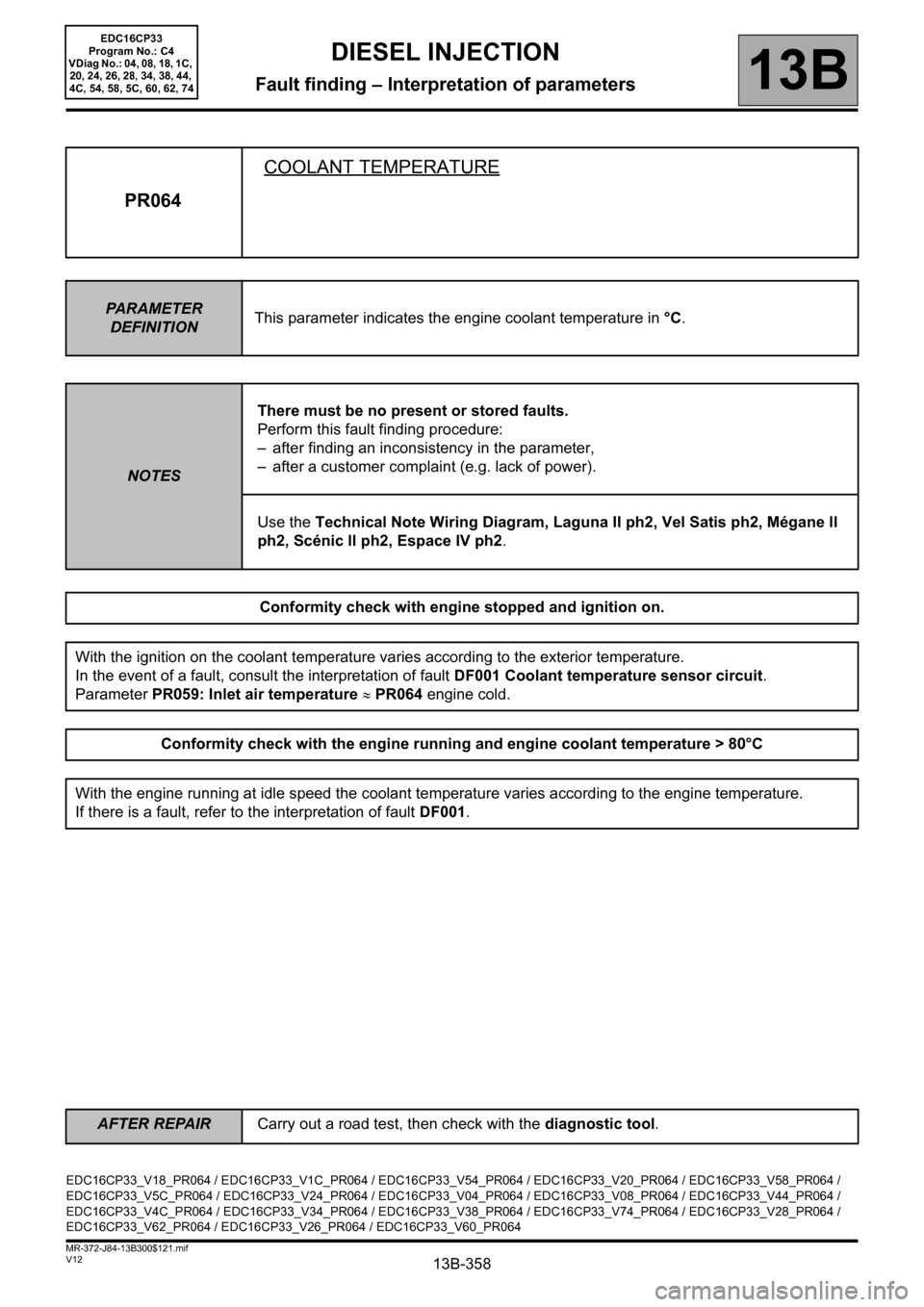
13B-358
AFTER REPAIRCarry out a road test, then check with the diagnostic tool.
V12 MR-372-J84-13B300$121.mif
DIESEL INJECTION
Fault finding – Interpretation of parameters13B
PR064COOLANT TEMPERATURE
PARAMETER
DEFINITIONThis parameter indicates the engine coolant temperature in °C.
NOTESThere must be no present or stored faults.
Perform this fault finding procedure:
– after finding an inconsistency in the parameter,
– after a customer complaint (e.g. lack of power).
Use the Technical Note Wiring Diagram, Laguna II ph2, Vel Satis ph2, Mégane ll
ph2, Scénic ll ph2, Espace IV ph2.
Conformity check with engine stopped and ignition on.
With the ignition on the coolant temperature varies according to the exterior temperature.
In the event of a fault, consult the interpretation of fault DF001 Coolant temperature sensor circuit.
Parameter PR059: Inlet air temperature ≈ PR064 engine cold.
Conformity check with the engine running and engine coolant temperature > 80°C
With the engine running at idle speed the coolant temperature varies according to the engine temperature.
If there is a fault, refer to the interpretation of fault DF001.
EDC16CP33_V18_PR064 / EDC16CP33_V1C_PR064 / EDC16CP33_V54_PR064 / EDC16CP33_V20_PR064 / EDC16CP33_V58_PR064 /
EDC16CP33_V5C_PR064 / EDC16CP33_V24_PR064 / EDC16CP33_V04_PR064 / EDC16CP33_V08_PR064 / EDC16CP33_V44_PR064 /
EDC16CP33_V4C_PR064 / EDC16CP33_V34_PR064 / EDC16CP33_V38_PR064 / EDC16CP33_V74_PR064 / EDC16CP33_V28_PR064 /
EDC16CP33_V62_PR064 / EDC16CP33_V26_PR064 / EDC16CP33_V60_PR064
EDC16CP33
Program No.: C4
VDiag No.: 04, 08, 18, 1C,
20, 24, 26, 28, 34, 38, 44,
4C, 54, 58, 5C, 60, 62, 74
Page 374 of 510
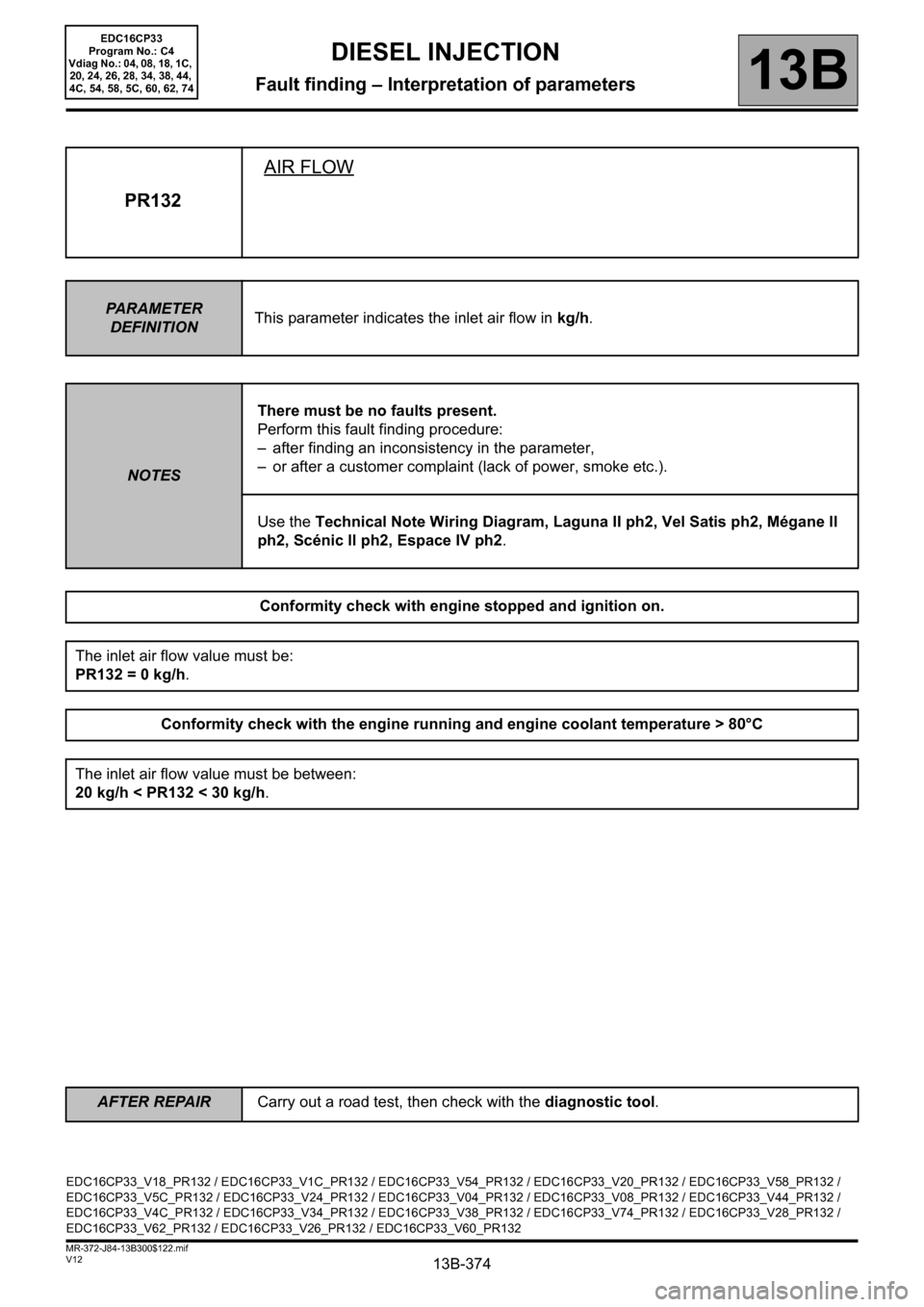
13B-374V12 MR-372-J84-13B300$122.mif
DIESEL INJECTION
Fault finding – Interpretation of parameters13B
PR132AIR FLOW
PARAMETER
DEFINITIONThis parameter indicates the inlet air flow in kg/h.
NOTESThere must be no faults present.
Perform this fault finding procedure:
– after finding an inconsistency in the parameter,
– or after a customer complaint (lack of power, smoke etc.).
Use the Technical Note Wiring Diagram, Laguna II ph2, Vel Satis ph2, Mégane ll
ph2, Scénic ll ph2, Espace IV ph2.
Conformity check with engine stopped and ignition on.
The inlet air flow value must be:
PR132 = 0 kg/h.
Conformity check with the engine running and engine coolant temperature > 80°C
The inlet air flow value must be between:
20 kg/h < PR132 < 30 kg/h.
EDC16CP33_V18_PR132 / EDC16CP33_V1C_PR132 / EDC16CP33_V54_PR132 / EDC16CP33_V20_PR132 / EDC16CP33_V58_PR132 /
EDC16CP33_V5C_PR132 / EDC16CP33_V24_PR132 / EDC16CP33_V04_PR132 / EDC16CP33_V08_PR132 / EDC16CP33_V44_PR132 /
EDC16CP33_V4C_PR132 / EDC16CP33_V34_PR132 / EDC16CP33_V38_PR132 / EDC16CP33_V74_PR132 / EDC16CP33_V28_PR132 /
EDC16CP33_V62_PR132 / EDC16CP33_V26_PR132 / EDC16CP33_V60_PR132
EDC16CP33
Program No.: C4
Vdiag No.: 04, 08, 18, 1C,
20, 24, 26, 28, 34, 38, 44,
4C, 54, 58, 5C, 60, 62, 74
AFTER REPAIRCarry out a road test, then check with the diagnostic tool.
Page 375 of 510
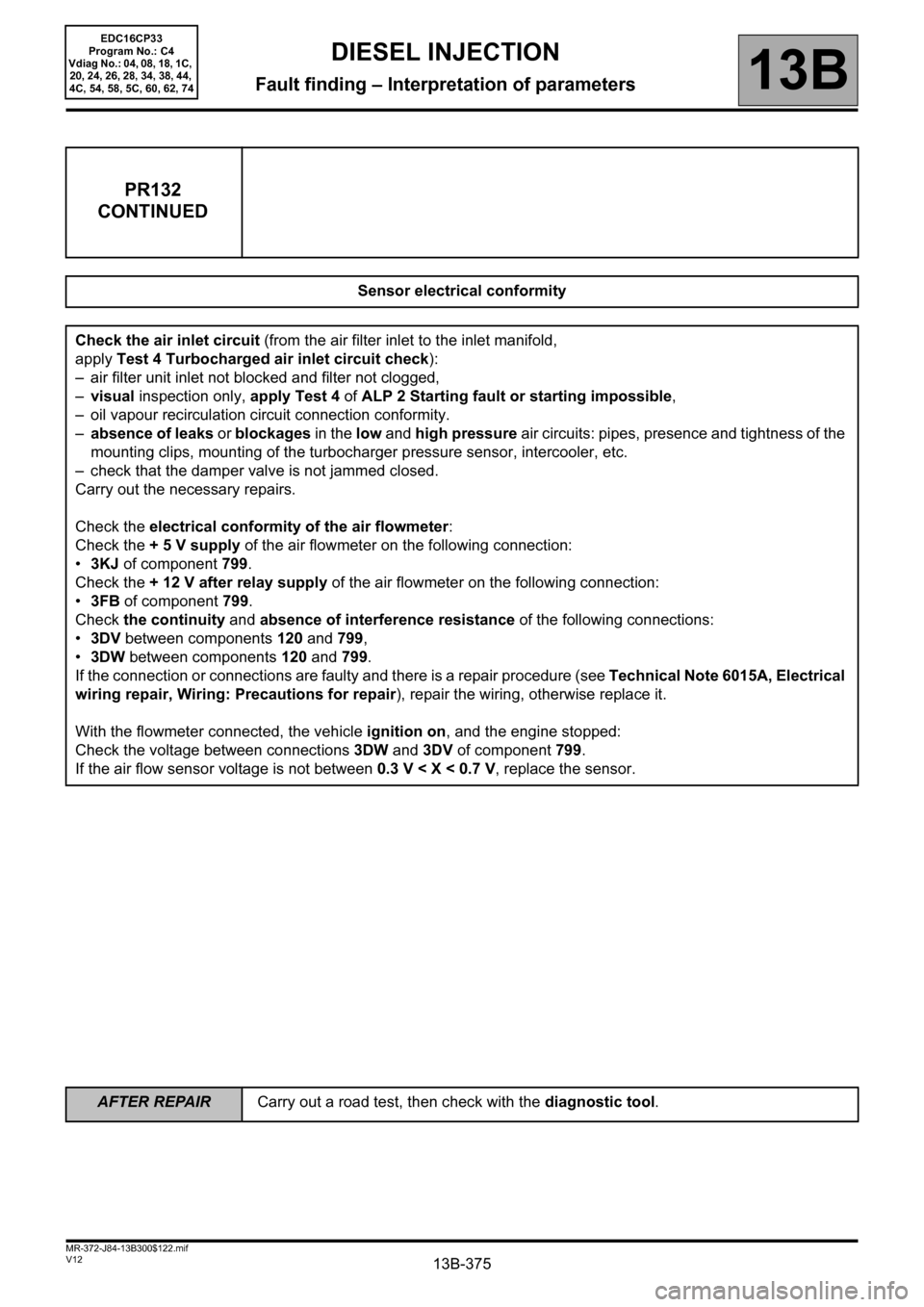
13B-375V12 MR-372-J84-13B300$122.mif
DIESEL INJECTION
Fault finding – Interpretation of parameters13B
PR132
CONTINUED
Sensor electrical conformity
Check the air inlet circuit (from the air filter inlet to the inlet manifold,
apply Test 4 Turbocharged air inlet circuit check):
– air filter unit inlet not blocked and filter not clogged,
–visual inspection only, apply Test 4 of ALP 2 Starting fault or starting impossible,
– oil vapour recirculation circuit connection conformity.
–absence of leaks or blockages in the low and high pressure air circuits: pipes, presence and tightness of the
mounting clips, mounting of the turbocharger pressure sensor, intercooler, etc.
– check that the damper valve is not jammed closed.
Carry out the necessary repairs.
Check the electrical conformity of the air flowmeter:
Check the + 5 V supply of the air flowmeter on the following connection:
•3KJ of component 799.
Check the + 12 V after relay supply of the air flowmeter on the following connection:
•3FB of component 799.
Check the continuity and absence of interference resistance of the following connections:
•3DV between components 120 and 799,
•3DW between components120 and 799.
If the connection or connections are faulty and there is a repair procedure (see Technical Note 6015A, Electrical
wiring repair, Wiring: Precautions for repair), repair the wiring, otherwise replace it.
With the flowmeter connected, the vehicle ignition on, and the engine stopped:
Check the voltage between connections 3DW and 3DV of component 799.
If the air flow sensor voltage is not between 0.3 V < X < 0.7 V, replace the sensor.
EDC16CP33
Program No.: C4
Vdiag No.: 04, 08, 18, 1C,
20, 24, 26, 28, 34, 38, 44,
4C, 54, 58, 5C, 60, 62, 74
AFTER REPAIRCarry out a road test, then check with the diagnostic tool.
Page 397 of 510
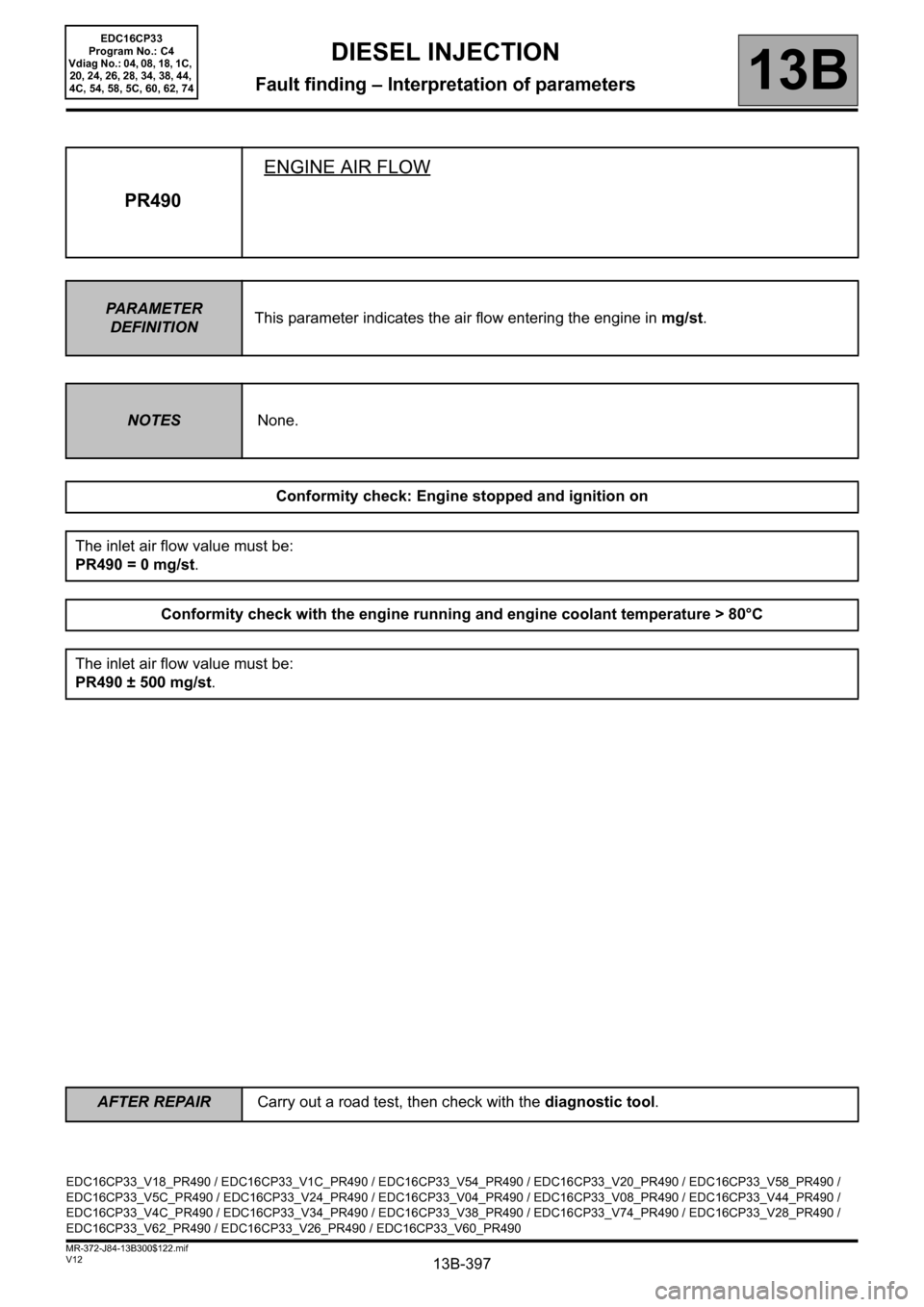
13B-397V12 MR-372-J84-13B300$122.mif
DIESEL INJECTION
Fault finding – Interpretation of parameters13B
PR490ENGINE AIR FLOW
PARAMETER
DEFINITIONThis parameter indicates the air flow entering the engine in mg/st.
NOTESNone.
Conformity check: Engine stopped and ignition on
The inlet air flow value must be:
PR490 = 0 mg/st.
Conformity check with the engine running and engine coolant temperature > 80°C
The inlet air flow value must be:
PR490 ± 500 mg/st.
EDC16CP33_V18_PR490 / EDC16CP33_V1C_PR490 / EDC16CP33_V54_PR490 / EDC16CP33_V20_PR490 / EDC16CP33_V58_PR490 /
EDC16CP33_V5C_PR490 / EDC16CP33_V24_PR490 / EDC16CP33_V04_PR490 / EDC16CP33_V08_PR490 / EDC16CP33_V44_PR490 /
EDC16CP33_V4C_PR490 / EDC16CP33_V34_PR490 / EDC16CP33_V38_PR490 / EDC16CP33_V74_PR490 / EDC16CP33_V28_PR490 /
EDC16CP33_V62_PR490 / EDC16CP33_V26_PR490 / EDC16CP33_V60_PR490
EDC16CP33
Program No.: C4
Vdiag No.: 04, 08, 18, 1C,
20, 24, 26, 28, 34, 38, 44,
4C, 54, 58, 5C, 60, 62, 74
AFTER REPAIRCarry out a road test, then check with the diagnostic tool.
Page 439 of 510
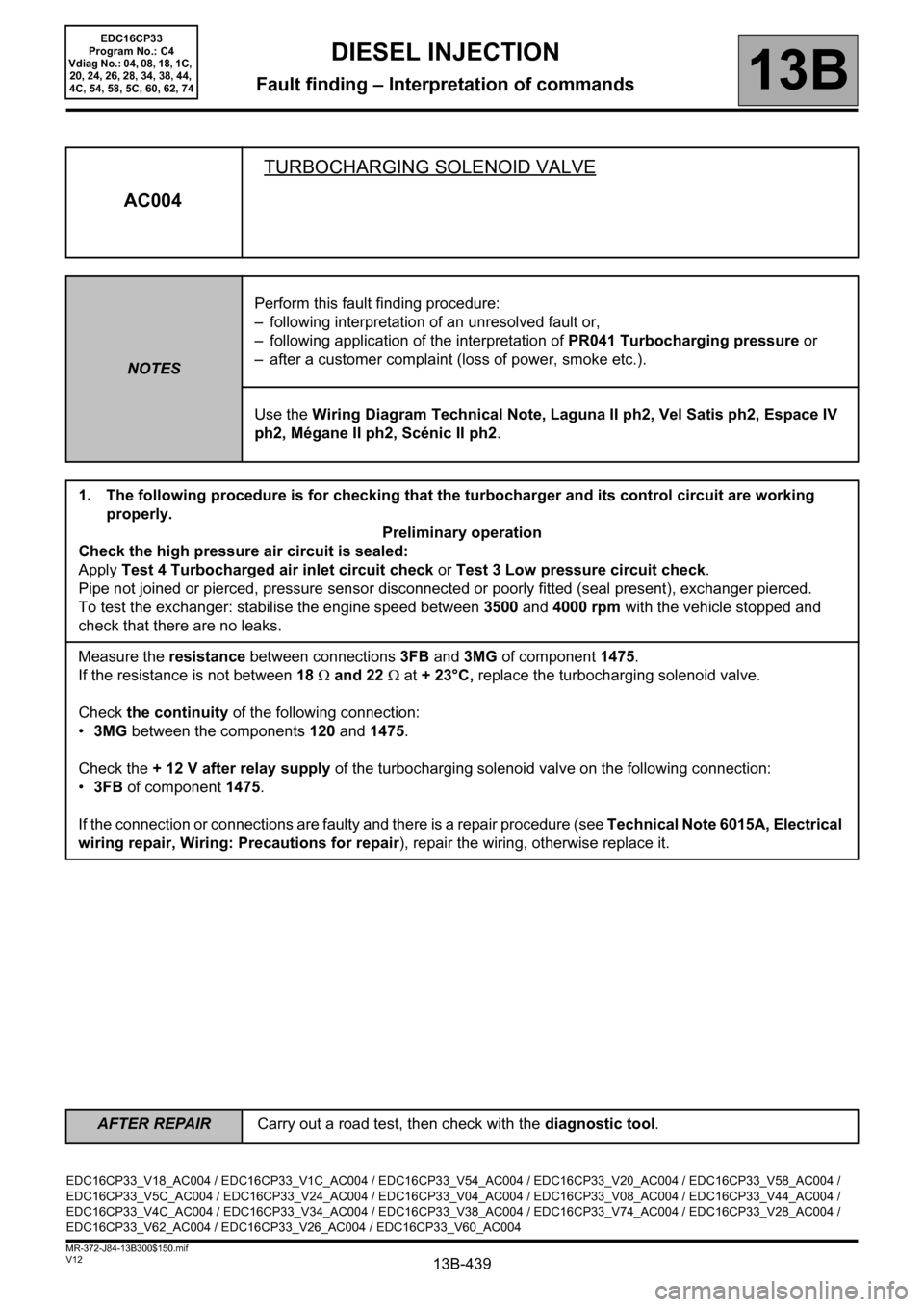
13B-439V12 MR-372-J84-13B300$150.mif
DIESEL INJECTION
Fault finding – Interpretation of commands13B
AC004TURBOCHARGING SOLENOID VALVE
NOTESPerform this fault finding procedure:
– following interpretation of an unresolved fault or,
– following application of the interpretation of PR041 Turbocharging pressure or
– after a customer complaint (loss of power, smoke etc.).
Use the Wiring Diagram Technical Note, Laguna II ph2, Vel Satis ph2, Espace IV
ph2, Mégane II ph2, Scénic II ph2.
1. The following procedure is for checking that the turbocharger and its control circuit are working
properly.
Preliminary operation
Check the high pressure air circuit is sealed:
Apply Test 4 Turbocharged air inlet circuit check or Test 3 Low pressure circuit check.
Pipe not joined or pierced, pressure sensor disconnected or poorly fitted (seal present), exchanger pierced.
To test the exchanger: stabilise the engine speed between 3500 and 4000 rpm with the vehicle stopped and
check that there are no leaks.
Measure the resistance between connections3FB and 3MG of component1475.
If the resistance is not between 18 Ω and 22 Ω at + 23°C, replace the turbocharging solenoid valve.
Check the continuity of the following connection:
•3MG between the components 120 and 1475.
Check the + 12 V after relay supply of the turbocharging solenoid valve on the following connection:
•3FB of component 1475.
If the connection or connections are faulty and there is a repair procedure (see Technical Note 6015A, Electrical
wiring repair, Wiring: Precautions for repair), repair the wiring, otherwise replace it.
EDC16CP33_V18_AC004 / EDC16CP33_V1C_AC004 / EDC16CP33_V54_AC004 / EDC16CP33_V20_AC004 / EDC16CP33_V58_AC004 /
EDC16CP33_V5C_AC004 / EDC16CP33_V24_AC004 / EDC16CP33_V04_AC004 / EDC16CP33_V08_AC004 / EDC16CP33_V44_AC004 /
EDC16CP33_V4C_AC004 / EDC16CP33_V34_AC004 / EDC16CP33_V38_AC004 / EDC16CP33_V74_AC004 / EDC16CP33_V28_AC004 /
EDC16CP33_V62_AC004 / EDC16CP33_V26_AC004 / EDC16CP33_V60_AC004
EDC16CP33
Program No.: C4
Vdiag No.: 04, 08, 18, 1C,
20, 24, 26, 28, 34, 38, 44,
4C, 54, 58, 5C, 60, 62, 74
AFTER REPAIRCarry out a road test, then check with the diagnostic tool.
Page 440 of 510
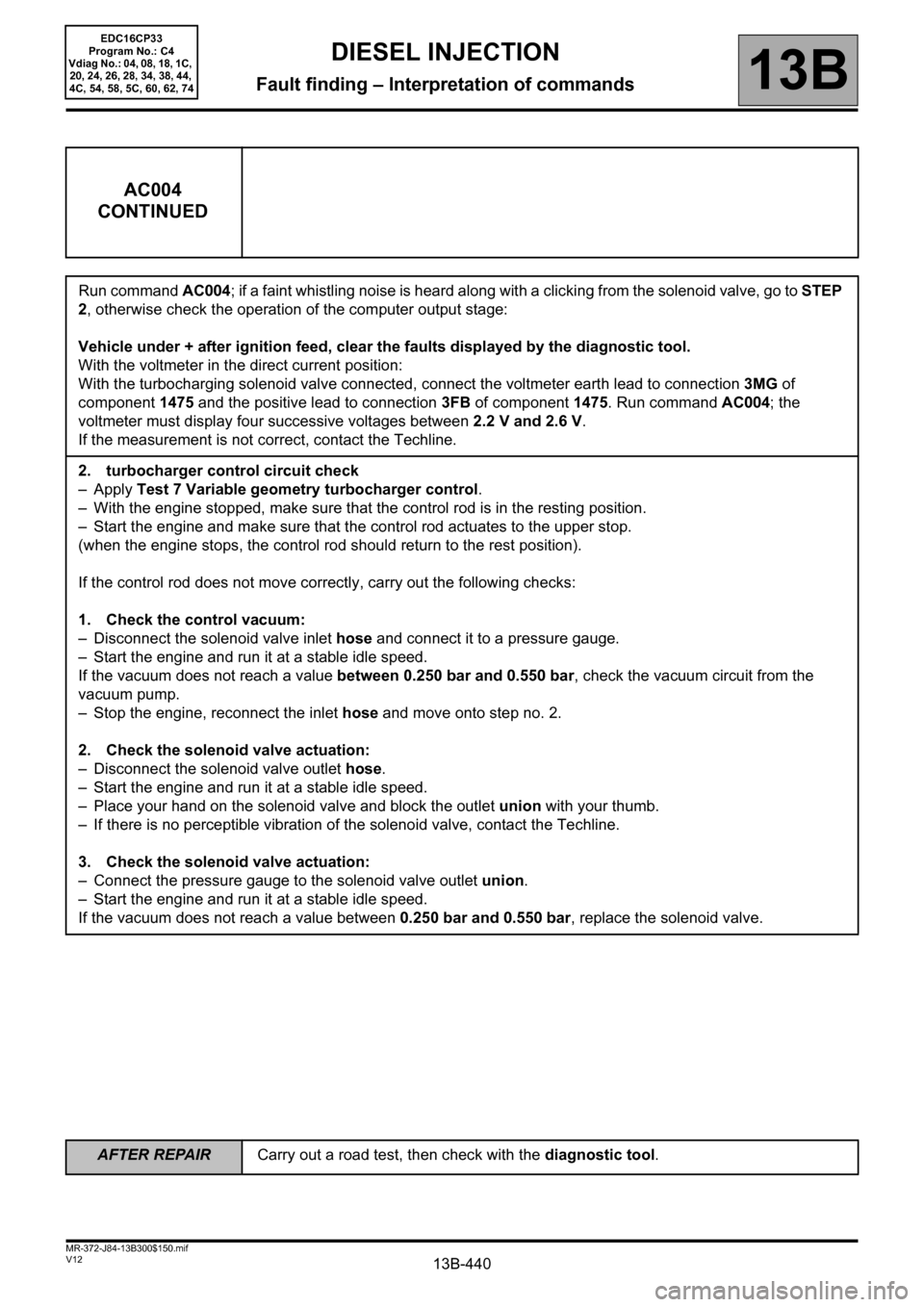
13B-440V12 MR-372-J84-13B300$150.mif
DIESEL INJECTION
Fault finding – Interpretation of commands13B
AC004
CONTINUED
Run command AC004; if a faint whistling noise is heard along with a clicking from the solenoid valve, go to STEP
2, otherwise check the operation of the computer output stage:
Vehicle under + after ignition feed, clear the faults displayed by the diagnostic tool.
With the voltmeter in the direct current position:
With the turbocharging solenoid valve connected, connect the voltmeter earth lead to connection 3MG of
component 1475 and the positive lead to connection 3FB of component 1475. Run command AC004; the
voltmeter must display four successive voltages between 2.2 V and 2.6 V.
If the measurement is not correct, contact the Techline.
2. turbocharger control circuit check
–Apply Test 7 Variable geometry turbocharger control.
– With the engine stopped, make sure that the control rod is in the resting position.
– Start the engine and make sure that the control rod actuates to the upper stop.
(when the engine stops, the control rod should return to the rest position).
If the control rod does not move correctly, carry out the following checks:
1. Check the control vacuum:
– Disconnect the solenoid valve inlet hose and connect it to a pressure gauge.
– Start the engine and run it at a stable idle speed.
If the vacuum does not reach a value between 0.250 bar and 0.550 bar, check the vacuum circuit from the
vacuum pump.
– Stop the engine, reconnect the inlet hose and move onto step no. 2.
2. Check the solenoid valve actuation:
– Disconnect the solenoid valve outlet hose.
– Start the engine and run it at a stable idle speed.
– Place your hand on the solenoid valve and block the outlet union with your thumb.
– If there is no perceptible vibration of the solenoid valve, contact the Techline.
3. Check the solenoid valve actuation:
– Connect the pressure gauge to the solenoid valve outlet union.
– Start the engine and run it at a stable idle speed.
If the vacuum does not reach a value between 0.250 bar and 0.550 bar, replace the solenoid valve.
EDC16CP33
Program No.: C4
Vdiag No.: 04, 08, 18, 1C,
20, 24, 26, 28, 34, 38, 44,
4C, 54, 58, 5C, 60, 62, 74
AFTER REPAIRCarry out a road test, then check with the diagnostic tool.
Page 451 of 510
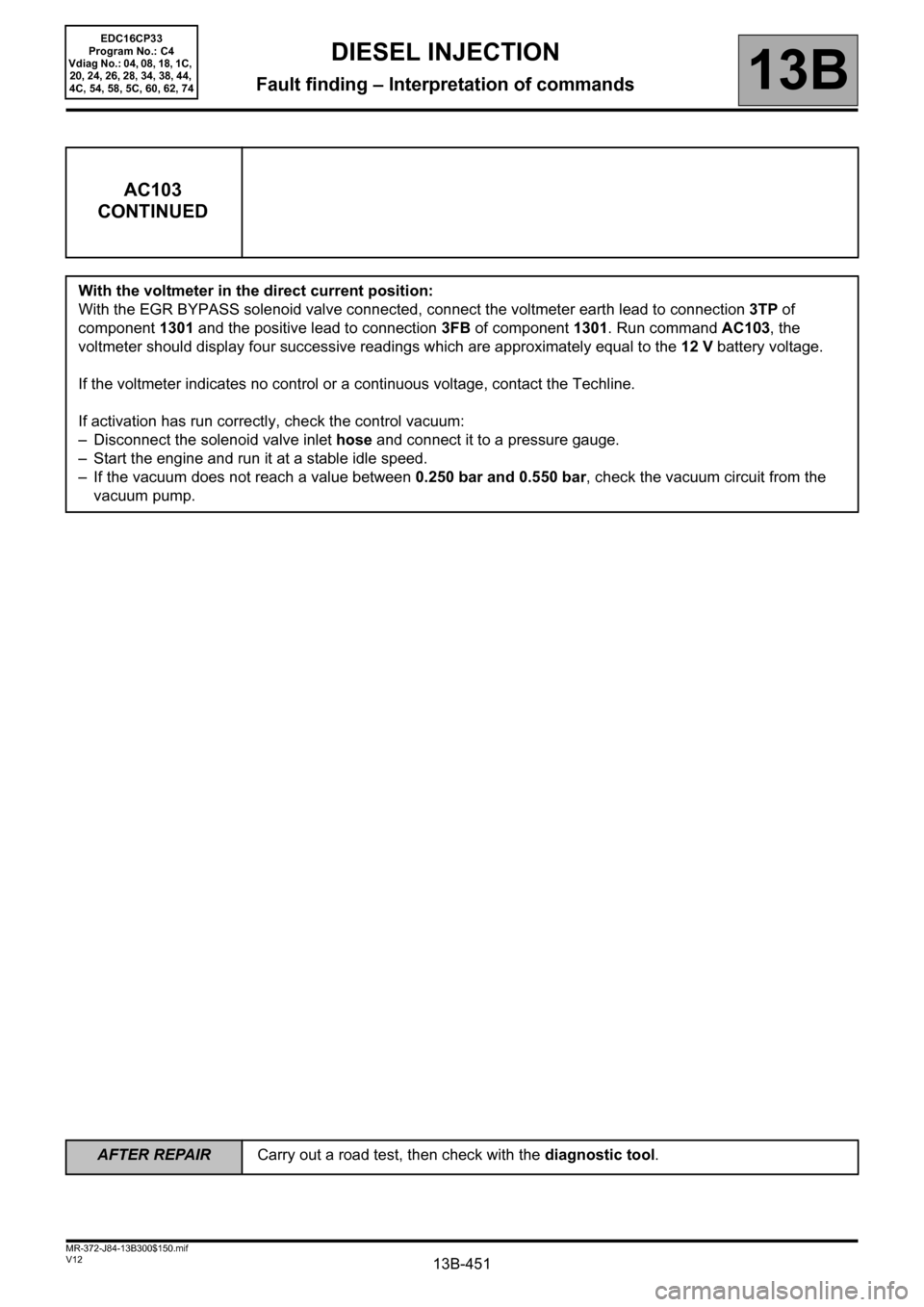
13B-451V12 MR-372-J84-13B300$150.mif
DIESEL INJECTION
Fault finding – Interpretation of commands13B
AC103
CONTINUED
With the voltmeter in the direct current position:
With the EGR BYPASS solenoid valve connected, connect the voltmeter earth lead to connection3TP of
component1301 and the positive lead to connection3FB of component1301. Run command AC103, the
voltmeter should display four successive readings which are approximately equal to the 12 V battery voltage.
If the voltmeter indicates no control or a continuous voltage, contact the Techline.
If activation has run correctly, check the control vacuum:
– Disconnect the solenoid valve inlet hose and connect it to a pressure gauge.
– Start the engine and run it at a stable idle speed.
– If the vacuum does not reach a value between 0.250 bar and 0.550 bar, check the vacuum circuit from the
vacuum pump.
EDC16CP33
Program No.: C4
Vdiag No.: 04, 08, 18, 1C,
20, 24, 26, 28, 34, 38, 44,
4C, 54, 58, 5C, 60, 62, 74
AFTER REPAIRCarry out a road test, then check with the diagnostic tool.
Page 459 of 510
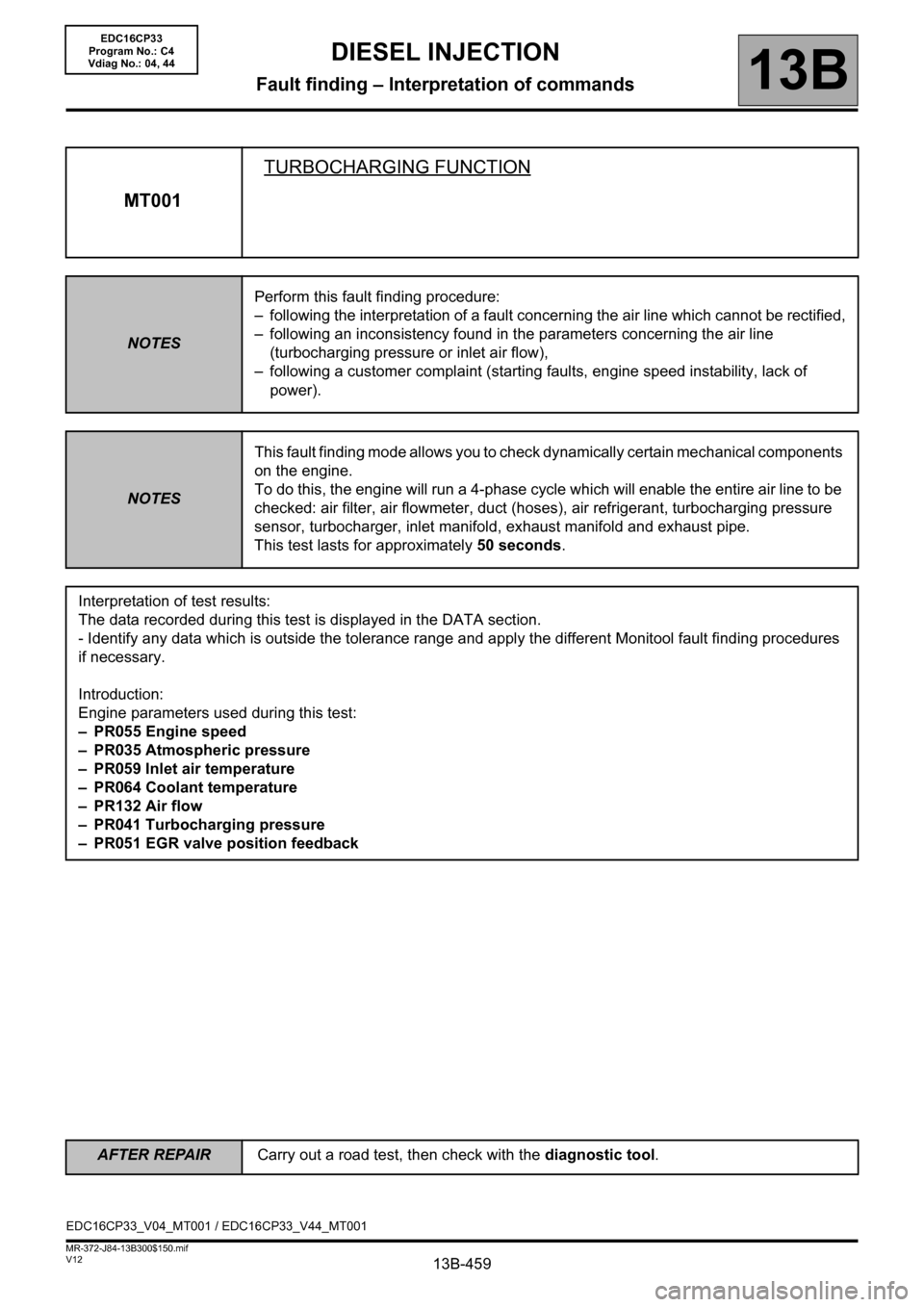
13B-459V12 MR-372-J84-13B300$150.mif
DIESEL INJECTION
Fault finding – Interpretation of commands13B
MT001TURBOCHARGING FUNCTION
NOTESPerform this fault finding procedure:
– following the interpretation of a fault concerning the air line which cannot be rectified,
– following an inconsistency found in the parameters concerning the air line
(turbocharging pressure or inlet air flow),
– following a customer complaint (starting faults, engine speed instability, lack of
power).
NOTESThis fault finding mode allows you to check dynamically certain mechanical components
on the engine.
To do this, the engine will run a 4-phase cycle which will enable the entire air line to be
checked: air filter, air flowmeter, duct (hoses), air refrigerant, turbocharging pressure
sensor, turbocharger, inlet manifold, exhaust manifold and exhaust pipe.
This test lasts for approximately 50 seconds.
Interpretation of test results:
The data recorded during this test is displayed in the DATA section.
- Identify any data which is outside the tolerance range and apply the different Monitool fault finding procedures
if necessary.
Introduction:
Engine parameters used during this test:
– PR055 Engine speed
– PR035 Atmospheric pressure
– PR059 Inlet air temperature
– PR064 Coolant temperature
–PR132 Air flow
– PR041 Turbocharging pressure
– PR051 EGR valve position feedback
EDC16CP33_V04_MT001 / EDC16CP33_V44_MT001
EDC16CP33
Program No.: C4
Vdiag No.: 04, 44
AFTER REPAIRCarry out a road test, then check with the diagnostic tool.
Page 463 of 510
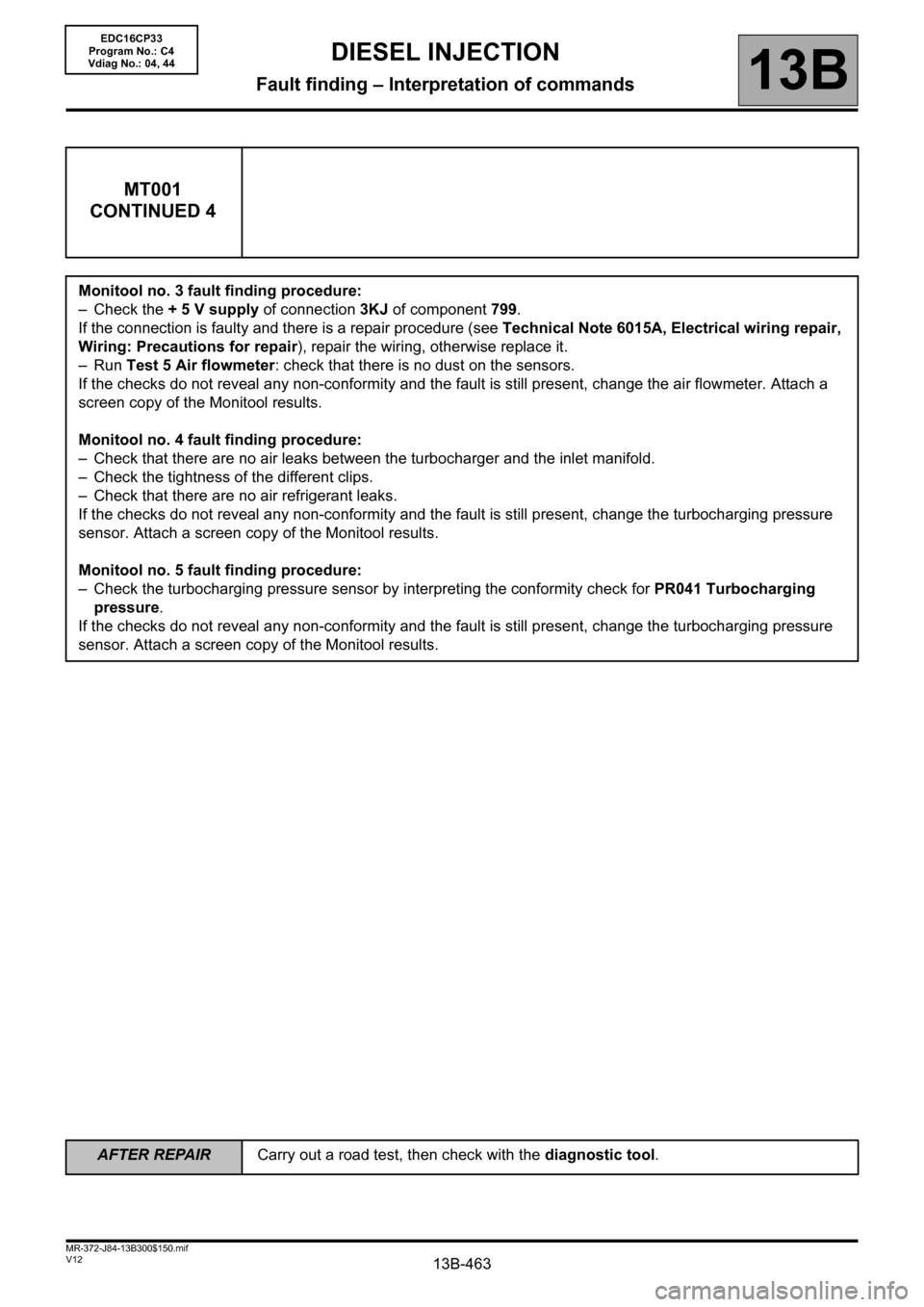
13B-463V12 MR-372-J84-13B300$150.mif
DIESEL INJECTION
Fault finding – Interpretation of commands13B
MT001
CONTINUED 4
Monitool no. 3 fault finding procedure:
– Check the + 5 V supply of connection 3KJ of component 799.
If the connection is faulty and there is a repair procedure (see Technical Note 6015A, Electrical wiring repair,
Wiring: Precautions for repair), repair the wiring, otherwise replace it.
– Run Test 5 Air flowmeter: check that there is no dust on the sensors.
If the checks do not reveal any non-conformity and the fault is still present, change the air flowmeter. Attach a
screen copy of the Monitool results.
Monitool no. 4 fault finding procedure:
– Check that there are no air leaks between the turbocharger and the inlet manifold.
– Check the tightness of the different clips.
– Check that there are no air refrigerant leaks.
If the checks do not reveal any non-conformity and the fault is still present, change the turbocharging pressure
sensor. Attach a screen copy of the Monitool results.
Monitool no. 5 fault finding procedure:
– Check the turbocharging pressure sensor by interpreting the conformity check for PR041 Turbocharging
pressure.
If the checks do not reveal any non-conformity and the fault is still present, change the turbocharging pressure
sensor. Attach a screen copy of the Monitool results.
EDC16CP33
Program No.: C4
Vdiag No.: 04, 44
AFTER REPAIRCarry out a road test, then check with the diagnostic tool.
Page 473 of 510
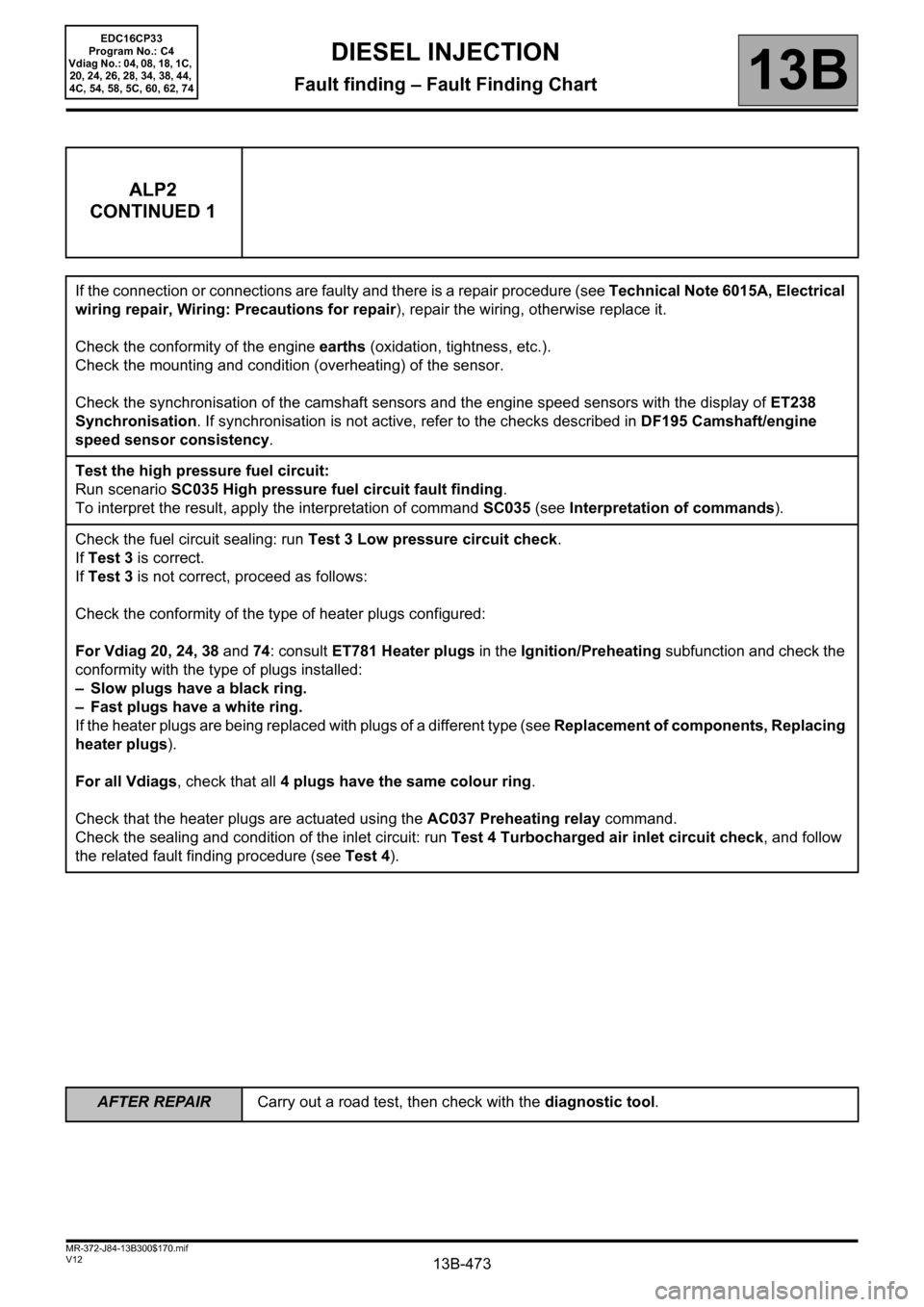
13B-473
AFTER REPAIRCarry out a road test, then check with the diagnostic tool.
V12 MR-372-J84-13B300$170.mif
DIESEL INJECTION
Fault finding – Fault Finding Chart13B
ALP2
CONTINUED 1
If the connection or connections are faulty and there is a repair procedure (see Technical Note 6015A, Electrical
wiring repair, Wiring: Precautions for repair), repair the wiring, otherwise replace it.
Check the conformity of the engine earths (oxidation, tightness, etc.).
Check the mounting and condition (overheating) of the sensor.
Check the synchronisation of the camshaft sensors and the engine speed sensors with the display of ET238
Synchronisation. If synchronisation is not active, refer to the checks described in DF195 Camshaft/engine
speed sensor consistency.
Test the high pressure fuel circuit:
Run scenario SC035 High pressure fuel circuit fault finding.
To interpret the result, apply the interpretation of command SC035 (see Interpretation of commands).
Check the fuel circuit sealing: run Test 3 Low pressure circuit check.
If Test 3 is correct.
If Test 3 is not correct, proceed as follows:
Check the conformity of the type of heater plugs configured:
For Vdiag 20, 24, 38 and 74: consult ET781 Heater plugs in the Ignition/Preheating subfunction and check the
conformity with the type of plugs installed:
– Slow plugs have a black ring.
– Fast plugs have a white ring.
If the heater plugs are being replaced with plugs of a different type (see Replacement of components, Replacing
heater plugs).
For all Vdiags, check that all 4 plugs have the same colour ring.
Check that the heater plugs are actuated using the AC037 Preheating relay command.
Check the sealing and condition of the inlet circuit: run Test 4 Turbocharged air inlet circuit check, and follow
the related fault finding procedure (see Test 4).
EDC16CP33
Program No.: C4
Vdiag No.: 04, 08, 18, 1C,
20, 24, 26, 28, 34, 38, 44,
4C, 54, 58, 5C, 60, 62, 74